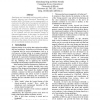Free Online Productivity Tools
i2Speak
i2Symbol
i2OCR
iTex2Img
iWeb2Print
iWeb2Shot
i2Type
iPdf2Split
iPdf2Merge
i2Bopomofo
i2Arabic
i2Style
i2Image
i2PDF
iLatex2Rtf
Sci2ools
ECLIPSE
2004
ACM
2004
ACM
Design mentoring based on design evolution analysis
Developing and consistently evolving quality software designs requires both theoretical knowledge and practical skills. The former can be communicated in a classroom; the latter has to be acquired with hands-on experience in software development. Our recent work on design evolution has resulted in a framework for analyzing the structural differences of subsequent versions of design artifacts, such as the logical design of OO software and the user-interface design of interactive applications. In this paper, we discuss how design-evolution analysis can be used to assist developers in their tasks of understanding the design rationale of the system at hand and to advise them on how to consistently maintain and evolve it.
| Added | 30 Jun 2010 |
| Updated | 30 Jun 2010 |
| Type | Conference |
| Year | 2004 |
| Where | ECLIPSE |
| Authors | Zhenchang Xing, Eleni Stroulia |
Comments (0)

